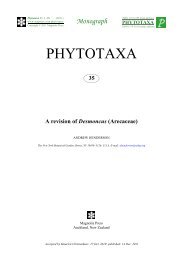Zootaxa, Taxonomy of Serpulidae (Annelida ... - Magnolia Press
Zootaxa, Taxonomy of Serpulidae (Annelida ... - Magnolia Press
Zootaxa, Taxonomy of Serpulidae (Annelida ... - Magnolia Press
Create successful ePaper yourself
Turn your PDF publications into a flip-book with our unique Google optimized e-Paper software.
Morphology<br />
The tube<br />
Whereas tubes <strong>of</strong> the closely related sabellid family are constructed <strong>of</strong> mucus and muddy or sandy sediments<br />
(e.g., Bonar 1972; with the exception <strong>of</strong> the calcareous tube in the sabellid Glomerula Nielsen, 1931<br />
(including Calcisabella Perkins, 1991), e.g., Vinn et al. 2008), all serpulids build tubes <strong>of</strong> crystalline calcium<br />
carbonate and a mucopolysaccharide matrix using calcium glands located on the collar (e.g., Neff 1968, 1971,<br />
Nott & Parkes 1975, Vovelle et al. 1991). Tube additions are molded by the collar folds when the worm is in a<br />
feeding position, at the entrance <strong>of</strong> the tube. The resulting tube shape depends upon the degree <strong>of</strong> rotation <strong>of</strong><br />
the worm within the tube and upon the morphology <strong>of</strong> the collar folds themselves (Faouzi 1930, Hanson<br />
1948b, Hedley 1956a, b, 1958).<br />
In spirorbins the tubes are coiled either dextrally or sinistrally in a tight flat spiral (the character that gave<br />
the name to the group) and are usually completely attached to the substrate (Helicosiphon Gravier, 1907 is an<br />
exception having the tube with erect distal end). In serpulins the tube shape is quite variable and coiling, when<br />
present, is irregular (maybe with the exception <strong>of</strong> Nogrobs grimaldii (de Montfort, 1808), but the tube <strong>of</strong> this<br />
taxon starts and ends with a straight part). In almost all serpulids the tubes are attached to the substrate by at<br />
least the proximal older parts. The only known exceptions are the free-living Ditrupa (Fig. 1A), and maybe<br />
Bathyditrupa, Nogrobs grimaldii, and Serpula crenata (Ehlers, 1908; possibly including S. sinica Wu & Chen,<br />
1979). Very likely larvae <strong>of</strong> these taxa settle on a pebble or a shell (as observed for D. arietina by Charles et<br />
al. (2003) and for S. crenata by ten Hove & Ben-Eliahu, unpublished), and break free later. Some serpulids<br />
have tubes attached to the substrate throughout their entire length (e.g., Pomatoceros triqueter (Linnaeus,<br />
1758)) while others have free erect distal parts (e.g., Hyalopomatus spp.). The direction <strong>of</strong> tube growth is<br />
apparently affected by environmental conditions (e.g., Knight-Jones 1981). Serpulids are able to deal with<br />
high rates <strong>of</strong> sedimentation by changing the shape and direction <strong>of</strong> tube growth (e.g., Hartmann-Schröder<br />
1967, 1971). Standing erect tubes are observed in waters with low current and high sedimentation rate; the<br />
most extreme example being that <strong>of</strong> Serpula israelitica Amoureux, 1976, with up to 10 cm long erect tubes<br />
embedded in sand (ten Hove, 16 June 1982, observation on Van Veen grab sample, CANCAP Expedition VI,<br />
Sta. 111, South <strong>of</strong> Santa Luzia, 55–62 m, sand). Tubes completely attached to the substrate may be indicative<br />
<strong>of</strong> water movements (currents, tides) with low rates <strong>of</strong> sedimentation (Kupriyanova & Badyaev 1998). A high<br />
density <strong>of</strong> tubes may result in the distal parts growing away from the substrate (e.g., Jackson 1977, Table 3).<br />
Tubes <strong>of</strong> some taxa, such as Floriprotis (Fig. 1E) and several Spirobranchus spp. (Fig. 1D) may be completely<br />
embedded in scleractinian corals (see review by Martín & Britayev 1998, Ben-Tzvi et al. 2006). These are not<br />
boring organisms, but settle on a dead coral part and become overgrown later.<br />
The importance <strong>of</strong> tubes in serpulid taxonomy is underestimated and adequate descriptions and figures are<br />
mostly absent in Recent descriptions. In some genera (e.g., Hydroides) the tube morphology is too uniform for<br />
general taxonomic use, but locally some Hydroides species can be recognized in the field by their tubes. In<br />
other genera (such as Filogranula, Pyrgopolon, Pseudovermilia) the tubes provide excellent diagnostic<br />
characters.<br />
Tube shapes. In external cross-section, tubes <strong>of</strong> many serpulids are circular or sub-circular when a<br />
flattened area <strong>of</strong> attachment is present. However, in some taxa the tube cross-sections may be notably<br />
triangular (Pomatoceros, Pomatostegus, Placostegus, Pseudovermilia, Fig. 2E) or sub-triangular with one<br />
major longitudinal keel (Laminatubus alvini ten Hove & Zibrowius, 1986). Tubes <strong>of</strong> Galeolaria having two<br />
major longitudinal keels can be considered as trapezoidal. Bathyditrupa hovei Kupriyanova, 1993b and<br />
Nogrobs grimaldii are unusual in having tubes rectangular in cross-section. Within a single tube changes may<br />
occur from trapezoidal to polyangular (Pyrgopolon differens (Augener, 1922): ten Hove 1973 Pl. IIB) or from<br />
triangular respectively trapezoidal/semicircular to circular (e.g., Pseudovermilia occidentalis (McIntosh,<br />
1885); Hydroides brachyacanthus Rioja, 1941a: ten Hove 1975 Pl. VII g, k; Imajima & ten Hove 1984 fig. 5).<br />
TAXONOMY OF SERPULIDS: STATE OF AFFAIRS<br />
<strong>Zootaxa</strong> 2036 © 2009 <strong>Magnolia</strong> <strong>Press</strong> · 7
















